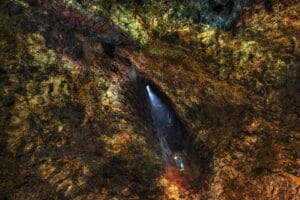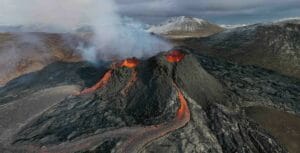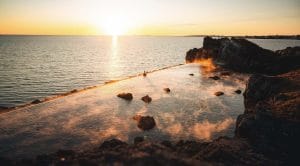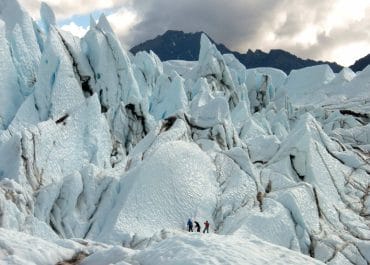The highlands of Iceland are a rugged and remote area that covers much of the country’s interior. This landscape is characterized by vast expanses of volcanic deserts, glaciers, and mountains, as well as hot springs and geysers. The highlands are only accessible during the summer months, as the roads are closed during the winter due to snow and ice. Visitors to the highlands can take guided tours to see the famous landmarks such as the Landmannalaugar, a geothermal area with a variety of colorful mountains, Vatnajökull, the largest glacier in Europe, and Þórsmörk. The highlands are also a popular destination for hikers and backpacking enthusiasts, who can explore the many trails that wind through the area. Despite the harsh conditions, the highlands of Iceland offer some of the most unique and beautiful natural scenery in the world.

What are the Highlands of Iceland?
The highlands of Iceland are very scarcely populated and are accessible to tourists for a very limited amount of time during the year because of their uncertain weather and next to impossible to cross terrain. Icelandic highlands are spread across an area of over 40,000 kilometers and are known as Europe’s largest unpopulated area. Highlands are like the mother of Iceland as it is the place where new land is formed and brought to the surface while the old, already formed landmasses are pushed towards the east and the west. So, highlands are basically the powerhouse of the country where new formations are constantly coming up and about.
However, the formation process in the highland has been halted for a long time now. The youngest highlands are the ones located in the southern part and they were formed during the Ice Age. So, it is safe to say that no new formation and shift has been seen after that. Iceland’s most attractive natural reserves are a part of the highlands which means that they attract a lot of tourists every year. From glaciers to waterfalls, volcanoes, geothermal areas, mountains, and canyons, there is barely any landform that you would not find here. The most famous hiking trail in Iceland and also one of the top hiking trails in the world is located in the highlands as well so, in short, there is no shortage of spots to hit for adventure seekers touring around the country.

Top Places to Visit in the Highlands of Iceland
The highlands of Iceland are quite vast and hence it can be confusing to decide the places that you actually would like to visit and get to have just the right kind of experience that you are looking for. Even when deciding on where to go, when visiting the highlands, there are a lot of places that you must avoid in order to not only stay safe but also because they are nothing but vast stretches of lands leading up to nowhere and hosting very uncertain weather conditions. We have made a list of the most noteworthy places that can be found in the highlands and will be a hoot to add to your travel itinerary. So, let us explore some of the most noteworthy attractions of the highlands of Iceland.
Thorsmork

Thorsmork or Þórsmörk valley is one of the top attractions in the highlands which is quite hard to reach and access. It is a natural reserve surrounded by three of the most prominent glaciers in Iceland: Eyjafjallajökull, Mýrdalsjökull, and Tindfjallajökull. Eyjafjallajökull and Mýrdalsjökull glaciers are very popular for housing one of the most active and rumbunctious volcanoes in Iceland – the volcano Katla. The valley is named after the Norse god of thunder – Thor.
Þórsmörk valley is the southern endpoint of the Laugavegur hike – the most popular hike in Iceland as well as the world and the starting point of the Fimmvörðuháls hiking trail which is a small extension hike to the previously mentioned Laugavegur hike. Þórsmörk valley is on the warmer end of the weather as compared to the rest of the central highlands since it is sheltered by three glaciers. The glaciers protect it from the high winds and the warmer weather lets the vegetation flourish properly.
Þórsmörk valley saw a huge increase in volcanic ash after the 2010 eruption of the Eyjafjallajökull glacier. This eruption famously halted all the air traffic coming from Europe. It took the valley a few months to get back to its former glory. Several migratory birds can be found in this valley covered with the beautiful black rock formation. Þórsmörk valley is a very popular spot for horse riding and camping. You can easily find several campsites in the area and spend some quality time under the stars.
It is possible to drive to the valley but you will need a 4×4 vehicle for that. The paths are rocky and you will have to cross a few rivers so, it is advisable that only experienced drivers try and drive to the Þórsmörk valley on their own. There are several tour buses or shuttles that travel to the valley as well so, if you are someone who would prefer not to risk driving, you can easily hop on one of these buses and enjoy the ride.
Kerlingarfjöll

These dark red colored mountains are certainly something to feast your eyes upon. The Kerlingarfjöll mountain range stretches across a range of 367 kilometers and houses the third biggest geothermal region in the area. A red-colored mountain range, Kerlingarfjöll is located on a volcanic hot spot which is clearly visible in its soil and the minerals that it possesses. Kerlingarfjöll mountain range used to be a popular ski resort in Iceland but it had to be closed since there was not enough snowfall for skiing there anymore, thanks to the rising temperature. Although a beautiful resort still stands there and known as the Highlands Resort which offers exceptional food and accommodation services.
The Kerlingarfjöll mountain range is a haven for those who would like to get some one on one time with the places which are next to untouched. One such place near Kerlingarfjöll is Hveradalir – an area covered with fuming hot springs waiting to be explored. You will have to rake a short hike from the resort to reach the hot spring however, the hiking trail is not marked for guidance. Although, it won’t be hard to find your way as the trail can be seen pretty clearly. Crampons and other hiking equipment are not necessary for this particular hike however, it is advised that you wear sturdy hiking boots. Your arrival point will be an area surrounded by the mountain range and covered with many small hot springs. There are several other small hikes from Hveradalir that you can take once you are done with the dips.
If you are into hikes more than anything else then The Circle Route hike is a must-try. It takes you around the whole Kerlingarfjöll range and is about 47 kilometers long. There are several mountain huts along the way so you can easily stay there if you do not want to camp out.
Landmannalaugar

The starting point to the most popular hike in Iceland and one of the best-known hikes in the world – the Laugavegur hike. Landmannalaugar is a group of beautiful hot pools which are surrounded by lush green mountains. The name Landmannalaugar translates to ‘the people’s pools’ and this area is best known for its hiking spots as well as the natural hot spring pools however, hiking takes the front seat now. Landmannalaugar pools used to be of great significance to travelers in olden times as they could easily stop here and get themselves clean as well as their cattle charged up by soaking in the warm waters. Even though now it is best known for being the northern end/starting point of the Laugavegur hike, many tourists still visit the place for the hot pools only.
As far as the scenery of the area is concerned, this is a place where you can get an absolutely gorgeous picture with an array of colors in it. Landmannalaugar and its surrounding mountain range create a scenic view that should not be missed by any nature lover. The reason that surrounding mountains are so colorful is the rock that they are made of – rhyolite. This peculiar rock offers a wide spectrum of colors including red, yellow, green, and pink, and also changes shade as per the passing light. Isolated, wild, beautiful, and hidden among a series of beautiful mountains, Landmannalaugar is the definition of a beauty.
Askja and Víti Craters

If you love the milky blue water of the Blue Lagoon then we suggest that you pay a visit to these small wonders of the highlands as well. Located towards the north of Vatnajökull glacier, Askja a series of calderas is a part of a huge complex of volcanoes named Dyngjufjöll mountains. The best thing to see here is the lake Öskjuvatn, the deepest lake of Iceland, which is located in Askja crater. The lake was formed in the recent eruption of the crater which happened in 1875 and flaunts beautiful azure-colored milky waters just like the Blue Lagoon.
Víti is one of the calderas that Askja has. It is popular for the hot, sulphuric geothermal water that it contains. Víti is an explosive crater of Askja and is quite a popular spot for people who enjoy natural bathing. However, there are several spots in the pool that are incredibly hot so if you do decide to take a dip in the pool, mind your steps, and test the temperature. A heavy 4×4 vehicle is required to travel to this area as the smaller 2×2 cars can not be safely driven here. There are no accommodation services near the calderas so if you plan to stay the night, you will have to camp. You can also check out some nearby hiking trails which are an interesting addition to the vicinity.
Lakagígar

Now a beautiful landscape, Lakagígar or the Laki crater was once the most horrifying of all the volcanic craters in Iceland. It erupted continuously between June 1783 to February 1784 and produced about 40 billion tons of basalt lava. The eruption also brought thick ash clouds which led to the death of about 50% of Iceland’s livestock which incidentally led to the demise of one-fourth of Iceland’s population. Not only that, the eruption widely affected many other countries across the globe. The monsoon cycles in Africa and India took a serious hit and Europe experienced continent-wide crop failure while the global temperature dropped significantly after 120 million tons of Sulphur Dioxide was released into the air due to the eruption.
Although, there are no visible signs of any volcanic activity in the crater now. The landscape has calmed down and turned into scenic heaven for photographers. The Laki crater has also been turned into a national reserve now. The magnificent black lava fields and the craters covered with bright green moss are definitely a sight to behold. The terrain leading to the Laki crater is quite harsh to travel. The ideal and the easiest way to travel is via air but if you prefer to drive then make sure that you choose a sturdy 4×4 vehicle for that.
Eldgja Canyon

Any adventurous trip to Iceland is incomplete if you do not visit the largest volcanic canyon in the world – Eldgja Canyon. This canyon is about 40 kilometers long, 270 meters deep, and 400 meters wide at its widest points. Located between the village of Kirkjubæjarklaustur and Landmannalaugar, the Eldgja canyon also offers a beautiful view of the waterfall with a natural bridge: Ófærufoss. The bridge, however, has collapsed now due to glacial flooding but the waterfall has retained its former mystical glory. There is also speculation that the Icelandic poem Völuspá was based on the eruption of the Eldgja canyon that occurred in 939 AD.
Aldeyjarfoss Waterfall

This waterfall is hands-down, one of the most beautiful waterfalls that one can get to see in the highlands. With a drop of 20 meters, the Aldeyjarfoss waterfall of the highlands is particularly known for the giant basalt columns that surround it and creates a stark contrast with the rest of the scenery. Imagine electric blue water falling down from in between the black, snow-coated basalt columns into the sea of the same electric blue water with white foam rising from the collision, sounds magical right? Well, it is an even better feeling when you see the same landscape first hand. The narrow opening for the fall and the large circular basin makes it a perfectly picturesque location for the photography enthusiast.
Another thing Aldeyjarfoss waterfall is famous for is kayaking. It features the longest free-fall in a kayak and has a Guinness World Record for the same. Several people sustained many injuries while kayaking here which is what made this waterfall so popular. All in all, it is a photographer’s biggest dream and a heaven for all thrill-seekers out there.
Hekla Volcano
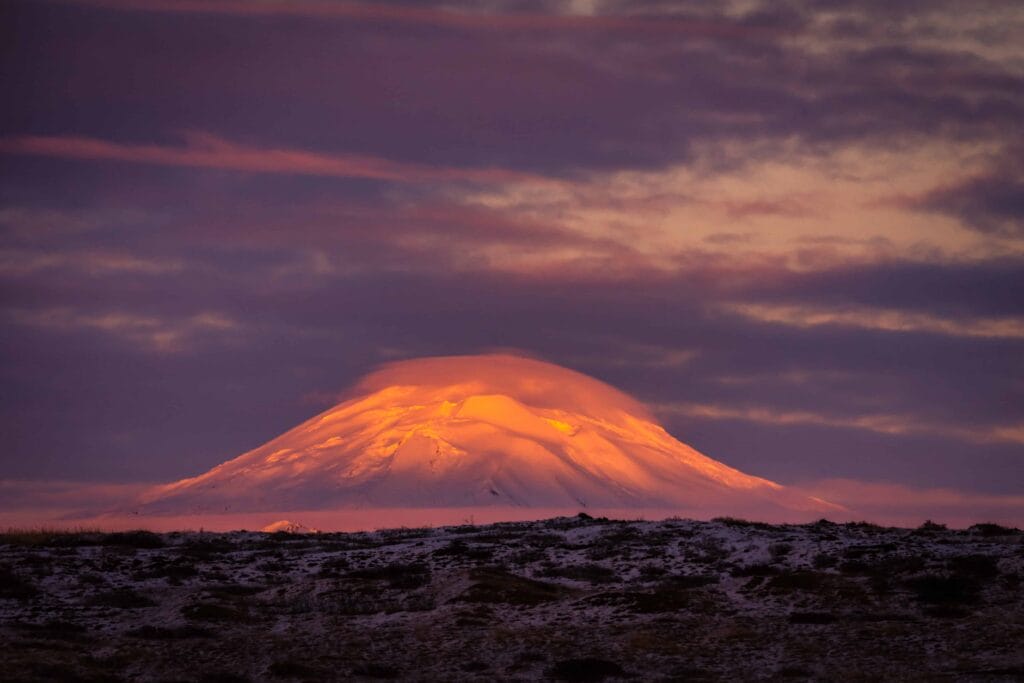
For a volcano that has erupted over 20 times since 870 AD, it is quite legitimate that Hekla is sometimes referred to as the “entrance to hell”. This should give you an idea about the havoc that this particular volcano must have wreaked on the island. Even though Hekla is not a volcano that would threaten the populated area of the country, the devastation caused by this volcano is something that cannot be put on the side-lines. Volcano Hekla’s most recent eruption happened in the year 2000. Volcano Hekla is a very popular attraction for mountaineers, hikers as well as the ones who love to ski and go snowmobiling. Not to mention the added dose of thrill that it brings into the picture.
Travel High, Travel Safe
The biggest challenge, as well as the biggest attraction of the highlands, is the level of harshness that the environment presents, the difficulty to cross terrains, and some of the hardest to reach travel destinations in the whole country. Although taking a trip to these places is quite safe and secure, it should be your priority to take extra care of safety and security when going into the highlands. Sturdy boots, warm clothes (layered properly), the right kind of vehicle, and full-fledged information on the place you are traveling to is of utmost importance to have. Given that you have taken all the security measures necessary, it is almost one hundred percent sure that you will have the time of your life when traveling to the highlands of Iceland.

